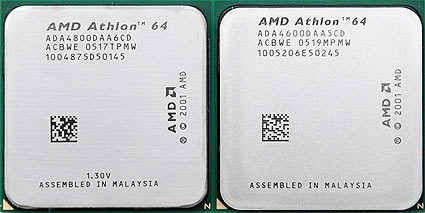Dual-Core, Simple Price: Athlon 64 X2 3800+
Athlon 64 X2: 1 Or 2 MB Of L2 Cache?
On the right, the Toledo with two 1 MB L2 caches; little brother Manchester on the left, with two 512 kB caches.
This latest chip is by no means a completely new product - it's based on the two current AMD processor designs. These are known as the Manchester and Toledo dual core chips; the former offers a 512 kB L2 cache for each core, and the latter 1 MB for each instead. The following table describes some vital stats for the various available X2 processors:
| Athlon 64 X2 | Core | L2-Cache | Clock Rate |
|---|---|---|---|
| 4800+ | Toledo | 2x 1 MB | 2.4 GHz |
| 4600+ | Manchester | 2x 512 kB | 2.4 GHz |
| 4400+ | Toledo | 2x 1 MB | 2.2 GHz |
| 4200+ | Manchester | 2x 512 kB | 2.2 GHz |
| 3800+ | Manchester | 2x 512 kB | 2.0 GHz |
While the Toledo chips can consume up to a maximum of 110 W, their Manchester counterparts max out at 89 W - barely more than Intel's Celeron D and Pentium 4 mainstream processors, as well as the fastest Athlon 64 single core models. Under lighter loads, power consumption dips still further. That means it's safe to assume that the new dual core X2 3800+ processor, with a clock rate of only 2 GHz, will run cooler than other models that run at 2.2 or 2.4 GHz.
The number of X2 models available also raises the question: "Which chip is most worth recommending?" As we've observed from our own benchmark results, boosting the base clock rate to 200 MHz produces better results than does adding more cache to a processor. It's also important to keep costs in mind as well: the 4400+ offers only small improvements over the 4200+, but also doesn't cost much more. Where the 4800+ is concerned, the same things holds true when it's compared to top-of-the-line Pentium (Extreme Edition) or FX-57 processors. It's only likely to be deployed when budgets are high and price-insensitive, or when more performance produces real bottom-line benefits.
Get Tom's Hardware's best news and in-depth reviews, straight to your inbox.
Current page: Athlon 64 X2: 1 Or 2 MB Of L2 Cache?
Prev Page AMD 64 X2 3800+ Next Page Athlon 64 X2 4800+ And 4400+
Patrick Schmid was the editor-in-chief for Tom's Hardware from 2005 to 2006. He wrote numerous articles on a wide range of hardware topics, including storage, CPUs, and system builds.
